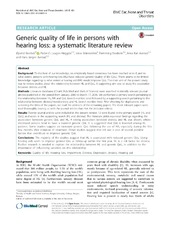| dc.contributor.author | Nordvik, Øyvind | en_US |
| dc.contributor.author | Heggdal, Peder Olaf Laugen | en_US |
| dc.contributor.author | Brännstrøm, Jonas | en_US |
| dc.contributor.author | Vassbotn, Flemming | en_US |
| dc.contributor.author | Aarstad, Anne Kari Hersvik | en_US |
| dc.contributor.author | Aarstad, Hans Jørgen | en_US |
| dc.date.accessioned | 2019-04-02T16:11:01Z | |
| dc.date.available | 2019-04-02T16:11:01Z | |
| dc.date.issued | 2018-01-22 | |
| dc.Published | Nordvik ØN, Heggdal POL, Brännstrøm J, Vassbotn F, Aarstad AKH, Aarstad HJ. Generic Quality of Life in persons With Hearing Loss: A Systematic Litterature Review. BMC Ear, Nose and Throat Disorders. 2018;18:1 | eng |
| dc.identifier.issn | 1472-6815 | |
| dc.identifier.uri | https://hdl.handle.net/1956/19270 | |
| dc.description.abstract | Background: To the best of our knowledge, no empirically based consensus has been reached as to if, and to what extent, persons with hearing loss (HL) have reduced generic Quality of life (QoL). There seems to be limited knowledge regarding to what extent a hearing aid (HA) would improve QoL. The main aim of the present study was to review studies about the relationship between HL and QoL. A supporting aim was to study the association between distress and HL. Methods: Literature databases (Cinahl, Pub Med and Web of Science) were searched to identify relevant journal articles published in the period from January 2000 to March 17, 2016. We performed a primary search pertaining to the relationship between HL, HA and QoL (search number one) followed by a supporting search pertaining to the relationship between distress/mood/anxiety and HL (search number two). After checking for duplications and screening the titles of the papers, we read the abstracts of the remaining papers. The most relevant papers were read thoroughly, leaving us with the journal articles that met the inclusion criteria. Results: Twenty journal articles were included in the present review: 13 were found in the primary search (HL and QoL), and seven in the supporting search (HL and distress). The literature yields equivocal findings regarding the association between generic QoL and HL. A strong association between distress and HL was shown, where distressed persons tend to have a lowered generic QoL. It is suggested that QoL is lowered among HL patients. Some studies suggest an increased generic QoL following the use of HA, especially during the first few months after initiation of treatment. Other studies suggest that HA use is one of several possible factors that contribute to improve generic QoL. Conclusions: The majority of the studies suggest that HL is associated with reduced generic QoL. Using hearing aids seem to improve general QoL at follow-up within the first year. HL is a risk factor for distress. Further research is needed to explore the relationship between HL and generic QoL, in addition to the importance of influencing variables on this relationship. | en_US |
| dc.language.iso | eng | eng |
| dc.publisher | BMC | eng |
| dc.rights | Attribution CC BY | eng |
| dc.rights.uri | http://creativecommons.org/licenses/by/4.0/ | eng |
| dc.subject | Quality of life | eng |
| dc.subject | Hearing loss | eng |
| dc.subject | Impairment | eng |
| dc.subject | Distress | eng |
| dc.subject | Depression | eng |
| dc.subject | Anxiety | eng |
| dc.subject | Hearing aid | eng |
| dc.title | Generic Quality of Life in persons With Hearing Loss: A Systematic Litterature Review | en_US |
| dc.type | Peer reviewed | |
| dc.type | Journal article | |
| dc.date.updated | 2018-02-12T13:50:10Z | |
| dc.description.version | publishedVersion | en_US |
| dc.rights.holder | Copyright 2018 The Authors | |
| dc.identifier.doi | https://doi.org/10.1186/s12901-018-0051-6 | |
| dc.identifier.cristin | 1564472 | |
| dc.source.journal | BMC Ear, Nose and Throat Disorders | |

